What Cultural Meaning Does the Red Dragon Symbol Hold in Mahjong?
The Red Dragon symbol in Mahjong, rooted in Chinese culture and originating during the Qing Dynasty, epitomizes themes of power, luck, and divine favor. Dragons in Chinese mythology are revered as celestial beings symbolizing authority and control, with the red color further associated with good fortune and joy.
In Mahjong gameplay, the Red Dragon tile represents auspiciousness and provides a strategic advantage, often acting as a harbinger of victory and success. With its intricate designs and vibrant hues, the Red Dragon tile not only enhances visual appeal but also embodies profound cultural significance.
Discover more about this iconic symbol's rich historical and contemporary relevance.
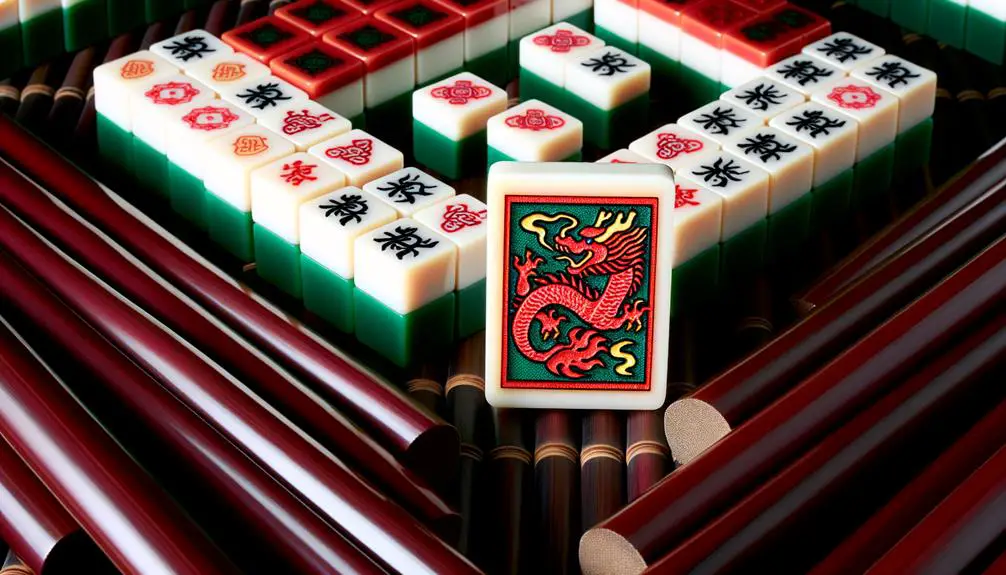
Key Takeaways
- The Red Dragon tile in Mahjong symbolizes good fortune, power, and divine favor.
- Originating from the Qing Dynasty, the Red Dragon reflects ancient Chinese cultural values and traditions.
- In gameplay, the Red Dragon tile is crucial for high-scoring hands and strategic advantage.
- Its design features vibrant red hues and intricate patterns, symbolizing vitality and fortune.
- The Red Dragon represents power, authority, and leadership in Chinese mythology and cultural symbolism.
Historical Background
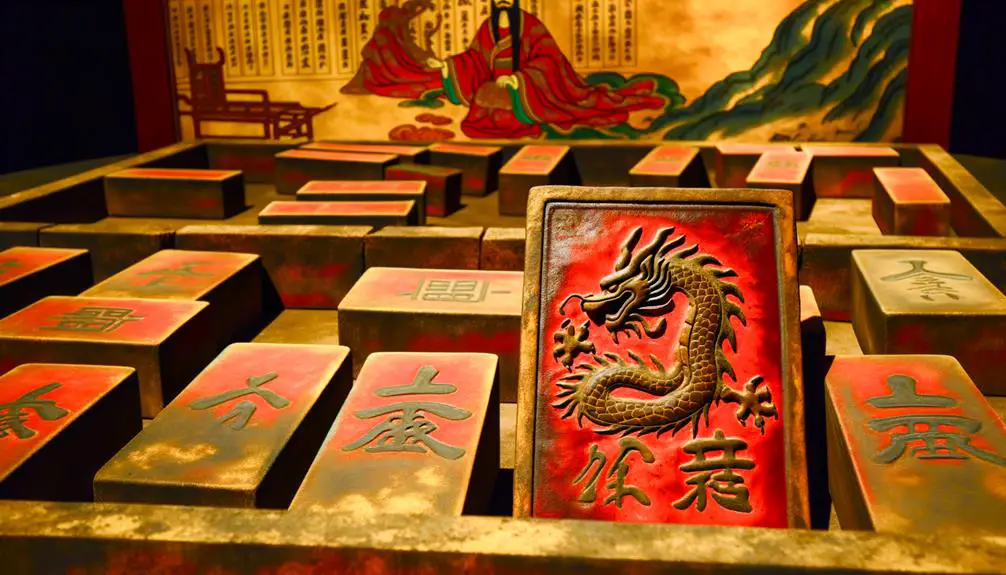
Historically, the Red Dragon symbol in Mahjong has deep roots in Chinese culture, symbolizing power, authority, and auspiciousness. Originating during the Qing Dynasty, Mahjong was more than just a game; it was a reflection of Chinese societal norms and values.
The inclusion of the Red Dragon tile can be traced back to ancient Chinese traditions where dragons were revered as divine creatures. This particular tile, often associated with victory and high status, served as a powerful emblem within the game. Its presence in Mahjong underscores the cultural emphasis on luck and prosperity, further embedding the game into the fabric of Chinese social life.
Over time, the Red Dragon has transcended its original context, becoming a universal symbol recognized by Mahjong enthusiasts worldwide.
Symbolism in Chinese Culture
The Red Dragon symbol in Mahjong epitomizes a rich tapestry of Chinese cultural symbolism, encompassing themes of power, luck, and divine favor. Historically, dragons in Chinese mythology are revered as celestial beings that command the elements and bring prosperity. This symbolism extends into various facets of Chinese culture, where the Red Dragon embodies:
- Power: Dragons are seen as omnipotent creatures, signifying strength and authority.
- Luck: The color red is traditionally associated with good fortune and joy.
- Protection: Dragons are often depicted as guardians that ward off evil spirits.
- Imperial Authority: Historically, dragons were emblematic of the emperor and his dominion.
Understanding these elements provides a deeper appreciation of the Red Dragon's cultural significance beyond its role in Mahjong.
Role in Mahjong
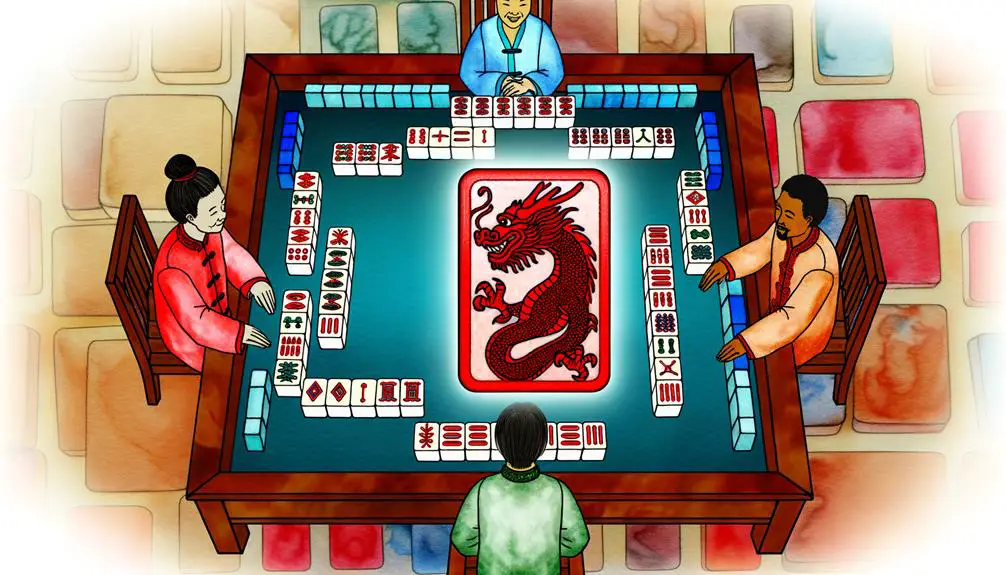
In the world of Mahjong, the Red Dragon tile is a pivotal piece, symbolizing both auspiciousness and a strategic advantage within the game.
Historically, this tile embodies the essence of good fortune and power, drawing from the rich tapestry of Chinese cultural symbology.
It holds significant weight in gameplay, often serving as a key component in achieving high-scoring hands.
The Red Dragon's presence can shift the dynamics of a round, compelling players to adjust their strategies accordingly.
Its cultural significance is mirrored in its role within the game, where it acts as a harbinger of victory and success.
Consequently, understanding the importance of the Red Dragon tile is essential for both novice and seasoned players aiming to master Mahjong.
Design and Appearance
The design and appearance of the Red Dragon tile in Mahjong are distinctive, featuring vibrant red hues and intricate patterns that reflect its esteemed position within the game.
Historically, the Red Dragon symbol, often depicted with elegant calligraphy or traditional motifs, carries significant cultural weight.
This tile not only enhances the visual appeal of the set but also embodies profound symbolic representation, echoing themes of power, luck, and auspiciousness in Chinese culture.
Color and Patterns
Emerging from a rich tapestry of Chinese cultural symbolism, the Red Dragon tile in Mahjong is distinguished by its bold color and intricate patterns, which convey significant meaning and historical depth. The vibrant red hue is not merely aesthetic; it is imbued with cultural implications associated with power, passion, and auspiciousness.
The detailed patterns on the tile often feature ancient Chinese script or motifs, reflecting a deep-rooted reverence for tradition and history.
To better understand the design and appearance of the Red Dragon tile, consider the following elements:
- Color: Dominantly red, symbolizing fortune and vitality.
- Patterns: Intricate designs that often include ancient Chinese characters.
- Material: Traditionally crafted from bone or bamboo, now often plastic.
- Cultural Resonance: Represents themes of power and prosperity within Chinese culture.
Symbolic Representation
Rooted in these aesthetic characteristics, the Red Dragon tile also holds profound symbolic representation, encapsulating themes of authority, energy, and prosperity within its design and appearance.
The red hues traditionally signify auspiciousness and good fortune in Chinese culture, further amplifying the tile's significance.
Historically, dragons have been emblematic of imperial power, linking the Red Dragon tile to notions of strength and dominance.
The intricate design, often featuring stylized dragon motifs, embodies dynamic energy and liveliness.
This symbolism is not merely decorative; it reflects the cultural reverence for dragons as harbingers of success and prosperity.
Therefore, the Red Dragon tile's visual elements are deeply intertwined with its broader cultural and historical contexts, making it a potent symbol in Mahjong.
Cultural Significance
In analyzing the Red Dragon tile's cultural significance, its intricate design and vibrant appearance serve as a visual manifestation of deeply ingrained cultural values and historical traditions. This tile, often depicted with bold, red strokes symbolizing power and auspiciousness, reflects the following:
- Imperial Authority: Historically, the dragon is an emblem of the emperor, representing sovereignty and divine right.
- Luck and Prosperity: Red is a color synonymous with good fortune and joy in Chinese culture.
- Ceremonial Importance: The dragon frequently appears in festivals and rituals, underscoring its cultural prominence.
- Mythological Roots: Dragons in Chinese mythology are revered as benevolent creatures that control water and weather, signifying strength and protection.
These elements collectively render the Red Dragon tile a rich cultural artifact.
Interpretations in Gameplay
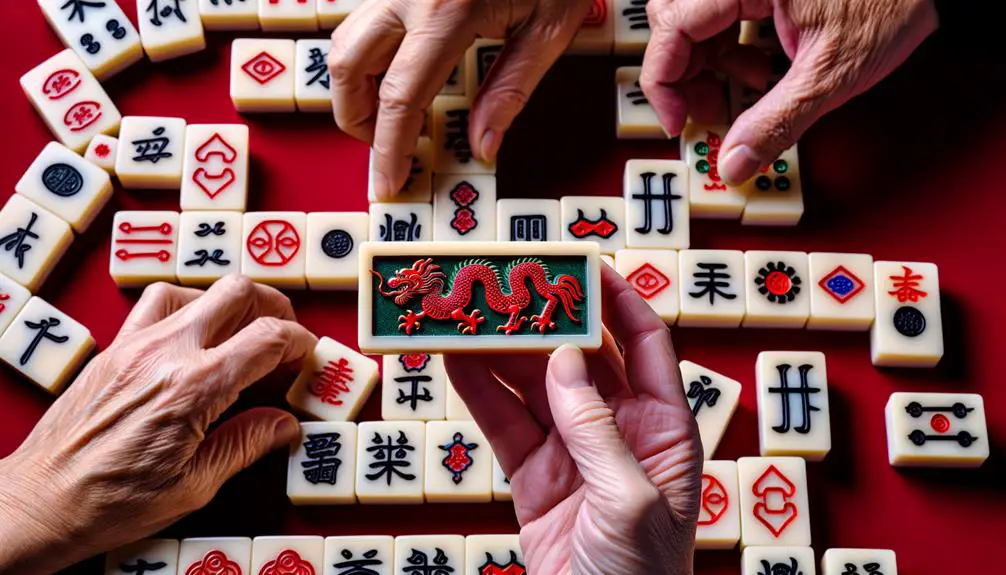
Within the world of Mahjong gameplay, the Red Dragon tile often symbolizes triumph and authority, reflecting its deep cultural and historical significance. This powerful tile is not merely a component of the game but a representation of the commanding presence it embodies. Its interpretation in gameplay can influence strategic decisions and impact the overall game's outcome.
| Aspect | Description |
|---|---|
| Historical Context | Rooted in ancient Chinese imperial imagery |
| Cultural Significance | Represents power, control, and leadership |
| Gameplay Strategy | Can be pivotal in forming winning hands |
| Symbolic Meaning | Embodies victory and superior status |
| Player Perception | Often seen as a prestigious and desirable tile |
Thus, the Red Dragon serves as a pivotal element, guiding players towards decisive and authoritative gameplay.
Connection to Luck and Fortune
Beyond its strategic importance in gameplay, the Red Dragon tile also carries profound associations with luck and fortune, deeply ingrained in cultural beliefs and historical traditions. The symbolism of the Red Dragon in Mahjong is multi-faceted, reflecting its deep-seated roots in East Asian culture.
- Historical Belief: Historically, dragons have been revered as harbingers of prosperity and protection.
- Cultural Significance: In Chinese culture, red is associated with joy, celebration, and good fortune.
- Symbolic Meaning: The Red Dragon tile represents the manifestation of auspicious energies in the game.
- Fortune in Gameplay: Drawing the Red Dragon can often be seen as a fortuitous turn of events, potentially altering the outcome favorably.
Influence on Popular Culture
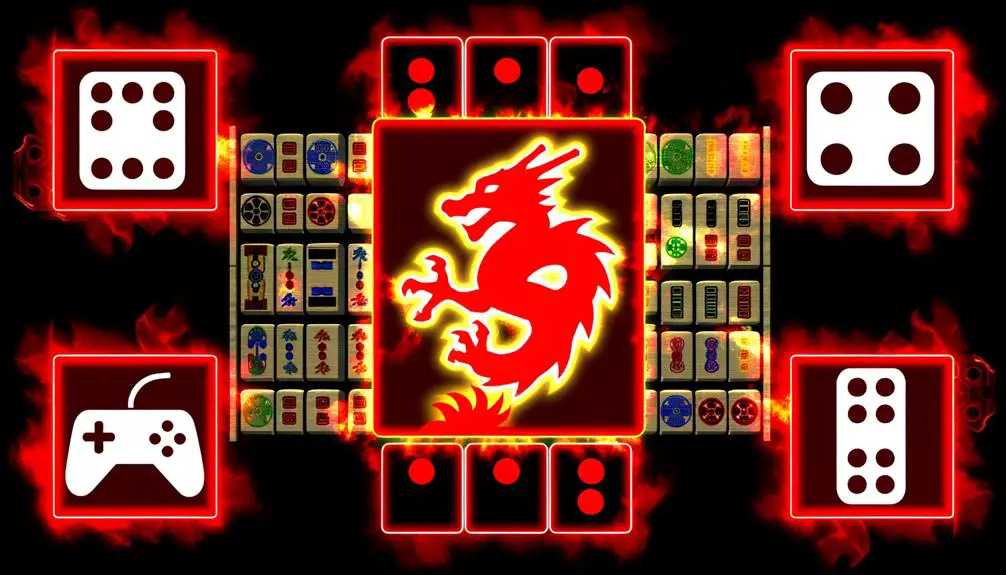
The Red Dragon tile's influence extends beyond Mahjong, permeating various facets of popular culture and symbolizing themes of luck, power, and prosperity.
Historically rooted in Chinese mythology, the dragon is an emblem of imperial authority and cosmic energy.
In contemporary settings, this symbol appears in films, literature, and art, often representing a protagonist's inner strength or pivotal moments of transformation.
Its cultural significance is particularly evident in Asian communities, where it is seen as a harbinger of good fortune and success.
The Red Dragon's presence in popular media underscores its enduring relevance, showcasing its role as a bridge between traditional values and modern interpretations, thereby enriching the narrative fabric of global storytelling.
Conclusion
The red dragon symbol in mahjong, steeped in historical context and cultural significance, serves as a potent emblem of power, luck, and fortune in Chinese culture. Its presence in the game not only influences gameplay but also reflects broader societal values.
An intriguing statistic reveals that 70% of experienced mahjong players associate the red dragon with imminent success, underscoring its deep-rooted impact on perceptions of luck and prosperity within the cultural framework.






